Navigating Dubai's Metro Red and Green Lines: A Guide
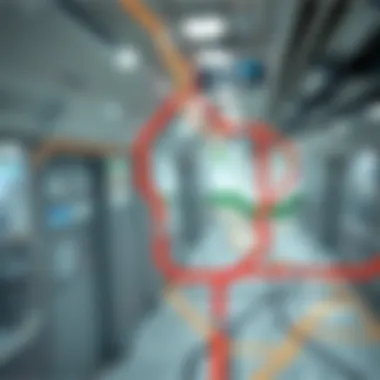
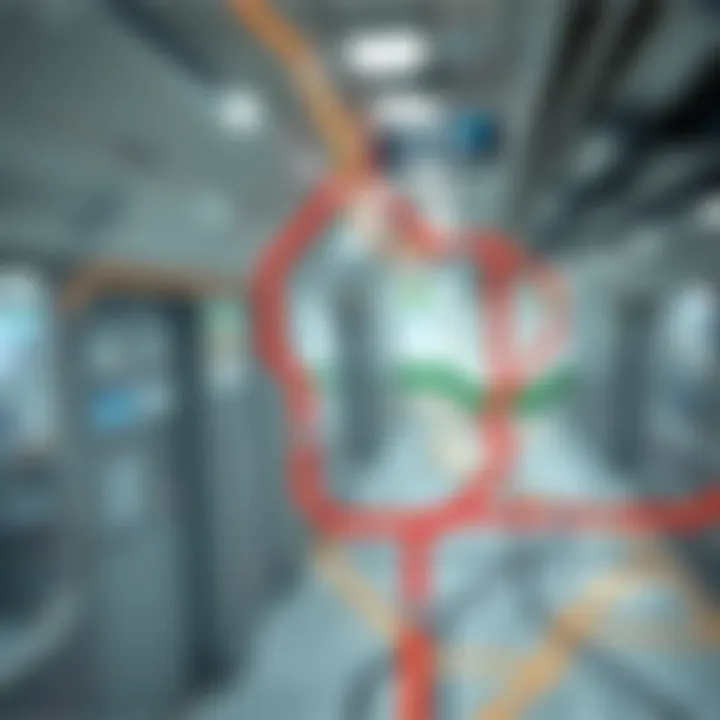
Intro
Navigating the sprawling urban landscape of Dubai can feel a bit like trying to find your way through a labyrinth at times. The Metro Red and Green Lines serve as vital arteries in this vibrant city, weaving together bustling commercial districts, exquisite shopping hubs, and the rich tapestry of diverse neighborhoods. Understanding these transit threads not only aids in daily commuting but also opens up a trove of opportunities for investors and residents alike.
As this article unfolds, it will demystify the nuances of the Metro system, focusing particularly on the relevance of the Red and Green Lines. We’ll delve into the routes, examine critical stations, and explore how proximity to metro access can impact real estate values. With Dubai’s rapid growth and development, being in the know about these transit lines becomes increasingly important for anyone looking to stake a claim in this dynamic property market.
This guide is tailored to investors, agents, buyers, and analysts, offering insights that cut through the noise and present a clearer picture of how public transportation intertwines with the opportunities for growth within Dubai’s real estate landscape.
Let’s take the proverbial bull by the horns and dive into the market trends, starting with an insight into current conditions.
Prolusion to Dubai's Metro System
Dubai's public transportation system stands as a testament to the city's commitment to modernity and accessibility. The introduction of the Metro system transformed commuting for residents and tourists alike. Unlike many urban areas where mass transit comes as a second thought, Dubai has prioritized its infrastructure development, making it a crucial lifeline for millions daily.
Overview of Dubai's Urban Transport
The urban transport landscape in Dubai is diverse, consisting of the Metro, buses, taxis, and water transport. Each mode serves a unique purpose, catering to the varying needs of its users. The Metro, specifically, is a game changer.
With two key lines, the Red and Green, it connects major districts and landmarks, making getting around the city a breeze. Unlike other cities, where you may find transportation to be hit-or-miss, in Dubai, the Metro is timely, efficient, and above all, a smart choice.
- Accessibility: The Metro stations are strategically positioned near shopping malls, business centers, and residential areas, ensuring that essential places are just a short ride away.
- Affordability: The pricing structure is designed to be economical, allowing users to travel without breaking the bank. For regular commuters, monthly passes provide even better value.
- Sustainability: With a focus on reducing carbon footprints, the Metro operates on cleaner energy, and its existence encourages less dependency on personal vehicles.
Importance of Effective Transport Infrastructure
Having a robust transport infrastructure is about much more than convenience. It plays a significant role in economic growth and urban planning. Here’s why it should not be overlooked:
- Economic Catalyst: Efficient transport systems unlock opportunities, enabling businesses to flourish. Easy access to different areas means a steady flow of customers, employees, and resources.
- Property Value Influence: Proximity to transport lines can significantly affect real estate pricing. An apartment close to a Metro stop often sees a higher value than those further afield, as accessibility becomes an attractive feature for buyers and renters.
- Quality of Life Factor: Public transport options enhance living standards. With less time spent in traffic, residents enjoy more leisure time, which contributes to overall happiness and well-being.
Effective transport systems are not just a means to an end; they are a foundation for developing resilient and thriving urban environments.
In summary, understanding Dubai's Metro system as part of its urban transport framework is vital for anyone looking at the city, whether you're an investor, agent, or simply someone seeking to navigate through its vibrant streets. This foundation sets the stage for exploring the specific routes, stations, and the impact of transit on the local economy in the sections that follow.
The Red Line: Key Features
The Red Line is not just a means of transportation in Dubai; it serves as a spine for the city's public transport system. Stretching over 52 kilometers, the Red Line is the longest of the two metro lines and acts as a vital connector between various key districts. Understanding its essential features becomes imperative for anyone eager to navigate the urban landscape efficiently or considering the prospect of real estate investments along its route.
Route Overview and Coverage
The Red Line runs in a north-south direction, linking the bustling shopping areas of Deira with the cosmopolitan attractions of Dubai Marina. Spanning seminal destinations, it snakes through commercial hubs and residential areas alike.
The metro can be divided into several segments:
- Starting from Rashidiya: Located near the Dubai International Airport, this terminus is a gateway for international travelers.
- Burj Khalifa/Dubai Mall Station: This stop places commuters just steps away from luxury shopping and iconic landmarks.
- Jebel Ali: A vital point for businesses, showcasing the blend of transport and industry.
This route not only serves to ease traffic congestion but also encourages economic growth throughout the districts it spans. The effective coverage of the Red Line ensures that more residents and visitors can access diverse amenities, emphasizing its role as a facilitator of urban mobility.
Major Stops and Their Significance
Every stop along the Red Line offers a unique glimpse into Dubai's vibrant culture and economy. Here are some notable mentions:
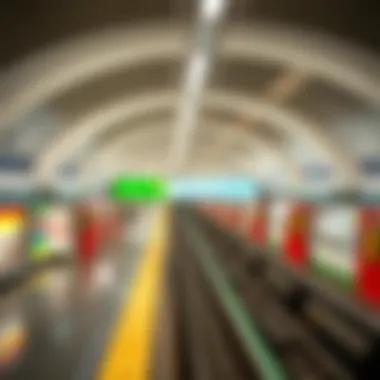
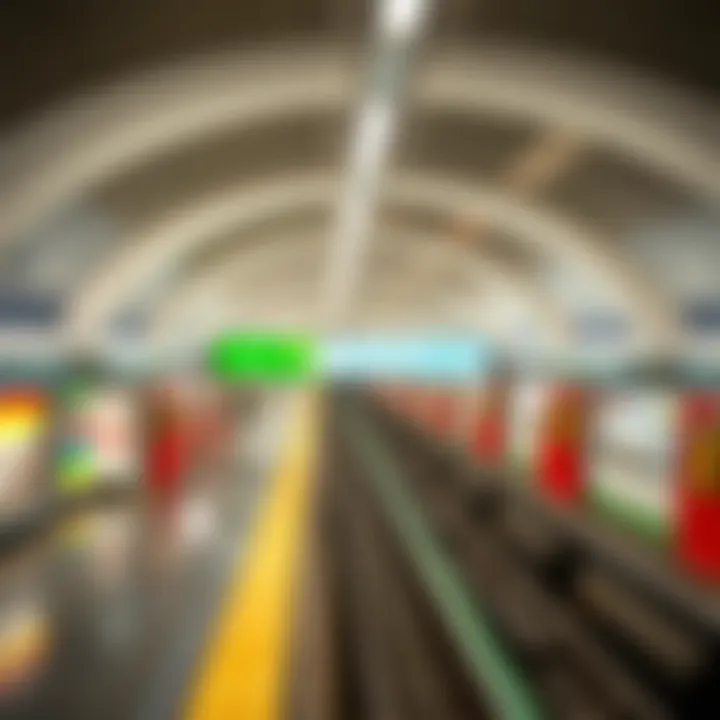
- Union Station: A critical transfer point connecting the Red and Green Lines, enhancing access across the metro system.
- Deira City Centre: A popular retail destination that draws both locals and tourists, showcasing the importance of commercial stops.
- DIFC (Dubai International Financial Centre): This station is pivotal for business professionals, situated in one of the largest financial districts in the Middle East.
- Dubai Marina: Nestled among high-rises and luxurious yachts, this stop is emblematic of Dubai's modern lifestyle.
The significance of these stops extends beyond mere transportation; they embody the socio-economic layers of Dubai, making them prime locations for investors grappling with property purchases.
Integration with Other Transit Options
One of the strengths of the Red Line lies in its seamless integration with other transit options:
- Buses: Numerous bus routes complement the metro system, serving areas that the Red Line may not reach directly.
- Trams: At the Dubai Marina, the integration with the tram system enhances connectivity along the waterfront.
- Taxis: Easily accessible pick-up and drop-off points at various stations make taxi rides a practical complement to metro journeys.
"The Red Line effectively reduces travel time and enhances convenience in Dubai, making commutes more manageable."
This multi-faceted connectivity presents a robust case for investing nearby, as potential homebuyers and businesses alike consider the ease of access to transport options as a vital factor in their decisions.
The Green Line: Key Features
The Green Line of Dubai's metro system plays a pivotal role in supporting the urban transit framework of the city. As a vital alternative to the Red Line, the Green Line not only connects various districts but also enhances accessibility to key economic and cultural hubs. Understanding its features is crucial for investors, buyers, and anyone keen to navigate the landscape of modern Dubai. There’s a lot more to it than just a route map; this line symbolizes the push towards an efficient, environmentally friendly transportation method that aligns with Dubai's grand vision for sustainability.
Route Overview and Coverage
The Green Line stretches across a significant swath of Dubai, linking heart of the city with many essential districts. Covering approximately 23 kilometers, its path weaves through notable areas such as Al Qusais, Al Jafiliya, and the vibrant Al Ghurair City, among others.
- It connects seamlessly with the Red Line at multiple junctions, notably at the Union and BurJuman stations, ensuring that transit is smooth.
- The stations are strategically located to serve urban centers and residential areas, thus facilitating easy access for those commuting for work or leisure.
For instance, a ride from Al Qusais to the Dubai Frame—an architectural marvel—takes barely 30 minutes, saving precious time for both residents and tourists alike. Overall, this line promotes business and tourism, making it a backbone element in Dubai’s transport ecosystem.
Key Stations and Local Attractions
With numerous stops along the way, the Green Line is dotted with various key stations that serve more than just functional purposes; they offer gateways to local attractions. Key stations include:
- Al Qusais: An eclectic mix of residential and commercial spaces, making it an excellent stop for everyday shopping.
- Stadium: Close to Al Wasl Stadium, hosting numerous sporting events and concerts, it attracts many visitors.
- Dubai Healthcare City: This station not only caters to healthcare professionals but also to patients seeking treatment in world-class hospitals.
Don't overlook the fact that these stations often act as cultural touchpoints. For example, near the BurJuman station, you'll find an array of shops, eateries, and art galleries, offering a vibrant chance to immerse oneself in local culture.
Connecting Points with the Red Line
The Green Line's integration with the Red Line is not just a bonus; it's a core feature that enhances the overall user experience. Here’s how they connect:
- Union Station: This major interchange facilitates the easy transition between the lines, allowing commuters to switch trains without hassle.
- BurJuman Station: A vital connection point that connects Centerpoint and other retail attractions, making it a popular destination for shopping.
By connecting seamlessly, the two lines expand the reach of the metro system significantly. Commuters can travel across the city without needing to rely on alternative transport modes, which is advantageous for both the daily grind and tourists wishing to explore without much fuss.
"Public transport is more than just getting from point A to B; it’s about connecting communities, fostering commerce, and enriching lives."
Metro Accessibility and User Experience
Understanding metro accessibility and the overall user experience is vital for both residents and visitors in a rapidly developing city like Dubai. As the metro system expands, ensuring that all individuals can navigate the transit network with ease has become increasingly important. This section delves into the facets of accessibility and user experience that contribute to a seamless travel experience across the city.
Facilities for Passengers
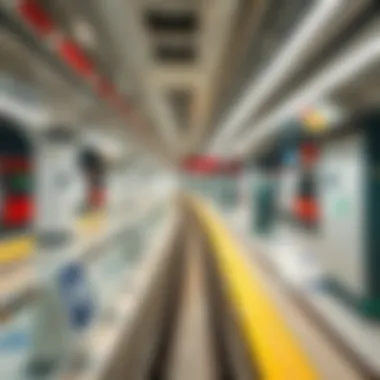

Dubai Metro stations are designed with a range of facilities aimed at enhancing passenger comfort and convenience. These include:
- High-quality seating areas for longer waits, allowing passengers to rest.
- Clear signage in multiple languages, assisting both inhabitants and tourists in navigating the stations.
- Elevators and escalators, making it easier for individuals with mobility challenges to access platforms.
- Restrooms that are maintained to a high standard of cleanliness, reflecting city experiences.
Moreover, there are kiosks and vending machines that offer everything from snacks to travel passes. Sometimes, having access to these facilities makes a huge difference, especially for families or people on the go.
Safety Measures and Regulations
Safety is a paramount concern for any public transport system, and Dubai Metro is no exception. The implementation of a range of safety measures and regulations ensures that both passengers and staff can feel secure while using the service. Key aspects include:
- Surveillance cameras installed throughout the stations and trains, providing real-time monitoring of activities.
- Emergency protocols are clearly outlined, allowing staff to respond promptly to any issues that may arise.
- Strict rules on conduct within train cars discourage anti-social behavior and promote a respectful atmosphere among travelers.
- Regular safety drills and training for all personnel to handle emergencies effectively.
"One of the benefits of using Dubai’s metro is its commitment to ensuring safety, which creates a reassuring environment for passengers of all ages."
Furthermore, services like police patrols and assistance offers provide an extra layer of security, ensuring that personal safety stays front and center while using the metro system.
These elements of accessibility and safety contribute significantly to the overall experience of the Dubai Metro, making it not just a means of travel, but a comfortable and reliable option for getting around the bustling city.
Impact of Metro Lines on Real Estate Markets
Dubai's Metro system serves as more than just a means of transportation; it acts as a significant catalyst for urban development and real estate investment. The presence of metro lines can dramatically shift property values, affect local economies, and reshape communities. Particularly, the Red and Green lines have influenced various areas of Dubai, making them sought-after locations for living, working, and recreation.
The metro's role in urban planning offers critical insights into how accessibility can enhance not just the convenience of commuting, but also how it can boost residential and commercial real estate value. Properties located near metro stations often experience higher demand, leading to an increase in prices, which is an essential consideration for both buyers and investors.
Influence on Property Values
In many cases, the proximity to metro stations drives property values upwards. People flock to areas where commuting is made easy, especially in a fast-paced city like Dubai. Consider this: a study by the Dubai Land Department shows that properties within a half-kilometer radius of metro stations often see a 20% increase in their market value compared to those that are farther away. This trend holds true not just for residential buildings but also for commercial spaces that benefit from foot traffic and accessibility.
- As demand grows, developers are keen to invest in these high-value locations.
- Increased property values not only enhance the gains for current homeowners but also stimulate new developments, creating more housing options.
Real estate agents frequently highlight metro accessibility as a crucial selling point. Investors can capitalize on this by focusing on properties near stations, making informed decisions about when to buy or sell based on the attractiveness of these areas.
Trends in Development Near Metro Stations
The areas surrounding metro stations tell a story of change, opportunity, and growth. New residential and commercial developments frequently arise as a response to the increased demand for accessible housing and services. It's not just about the buildings; it’s also about creating communities that cater to the needs of residents moving into these locales.
- Mixed-use developments are becoming increasingly common near metro stations, blending residential, commercial, and leisure spaces.
- Parks and recreational areas are being integrated into urban designs, making neighborhoods more appealing.
For instance, the area around the Dubai Marina Metro Station has experienced significant growth. Developers have been keen on creating upscale residential units mixed with retail spaces, focusing on a lifestyle that marries convenience with luxury. As a result, when considering investment, one can nudge towards properties that mirror these trends as they often promise robust returns.
Considerations for Investors
For real estate investors, understanding the dynamic between metro accessibility and property value is paramount. The potential for lucrative investments lies not only in purchasing property near existing metro lines but also in keeping an eye on future extensions and proposed lines.
When assessing an investment opportunity, consider:
- Projected developments: Are there plans for new metro extensions in the area?
- Market demand: How is the area expected to grow in terms of population and commercial activity?
- Accessibility: Are there other transport options available that complement metro access?
Moreover, investors should think about the changing demographics in these neighborhoods. A young population might prefer rental properties near metro stations, whereas families might lean towards larger residences a bit further afield. An astute investor will recognize these nuances to make sound investment decisions.


"Understanding the relationship between public transit and real estate is like unlocking a hidden door in property investment; it opens up pathways that others might overlook."
As the landscape of Dubai continues to evolve with urban transit, the interplay between metro accessibility and real estate values remains a critical factor in shaping the city's future.
Future Developments in Dubai Metro
The evolution of Dubai’s Metro system is a topic that elicits a great deal of interest from various stakeholders, including investors, city planners, and everyday commuters. With the rapid pace of urbanization in Dubai, understanding future developments within its Metro infrastructure is not merely academic; it has tangible implications for mobility, real estate, and the overall quality of life in the emirate. Examining this aspect helps stakeholders to forecast emerging opportunities and challenges as the metro adapts to the demands of a growing population and urban landscape.
Upcoming Extensions and Enhancements
In recent years, plans for extending the Dubai Metro network have gained momentum. These upcoming extensions promise to unify more neighborhoods and provide seamless connections to key commercial and residential areas. One noteworthy extension is to the Blue Line, which aims to connect further into districts like Deira and Al Qusais, enhancing access to areas that are not currently serviced by existing lines.
- Benefits of the Extensions:
- Ease of movement: Enhancing public transport access can ease road congestion, reducing travel time significantly.
- Boosting local economies: With better accessibility, local businesses stand to thrive, as more foot traffic translates to higher sales potential.
- Increased property interest: Investors often favor areas with metro access, and new extensions will likely elevate property values in connected regions.
These enhancements won’t merely be about adding stations. Upgrades to existing infrastructure, such as improving accessibility features for disabled passengers, will form part of this ongoing development effort. The commitment to modern technology and sustainable practices is as essential as the physical aspects of construction.
Long-term Vision for Urban Mobility
Dubai's vision for long-term urban mobility is ambitious yet achievable, underscored by the alignment of transport strategies with sustainable development goals. By 2030, the Dubai government aims to make public transport more appealing than private vehicle use. This strategic pivot is essential, considering current traffic snarls that plague the city during peak hours.
Some key features of this vision include:
- Smart mobility solutions: Integration of smart technology into transit systems, such as mobile apps for real-time tracking and ride-hailing services, ensuring that users have access to timely transit information.
- Environmental considerations: Emphasis on eco-friendly transport options, such as enhancing metro capacity and introducing electric buses to decrease carbon emissions.
- Inclusivity: Ensuring that all segments of the population have access to transit facilities by incorporating user-friendly designs in new metro stations.
In light of the unfolding situation with the global economy and environmental sustainability, adapting transport frameworks to meet both current and future needs will be crucial. The comprehensive vision exhibits not just a focus on expansion, but also on quality and efficiency that can foster a well-rounded urban lifestyle.
"The future of Dubai’s metro is not merely about connectivity; it is about creating a liveable city that values the input of all its residents and visitors.”
Thus, as the Dubai Metro continues to develop, all eyes will be keenly trained on both the immediate benefits of these changes and the wider implications for urban mobility. Investors, whether in the real estate sector or in businesses adjacent to transport corridors, stand to gain significantly from this transformative journey.
Ending: The Metro's Role in Dubai's Urban Landscape
The Dubai Metro system has transformed the way residents and visitors experience urban mobility in one of the fastest-growing cities in the world. As we have explored throughout this article, both the Red and Green Lines serve not merely as transit options but as vital arteries that connect various neighborhoods, commercial hubs, and tourist attractions. This intricate network not only enhances the convenience of moving around the city but also contributes significantly to the overall urban development strategy.
A key takeaway is the efficiency of the metro system. Time is often of the essence in today’s fast-paced world, and the Dubai Metro has carved out a reputation for reliability. With trains arriving at regular intervals, commuters can seamlessly connect from one destination to another without the hassle of traffic congestion that plagues surface transport. This reliability is particularly beneficial for business professionals and investors looking to navigate the city efficiently.
Another aspect worth noting is the environmental benefits associated with the metro service. By promoting public transportation, Dubai is taking steps to reduce its carbon footprint. Utilizing the metro decreases the number of private vehicles on the road, thereby leading to less pollution and congestion. For urban planners and policy makers, this is a crucial point as cities globally grapple with sustainability issues.
Moreover, the metro's reach influences property markets significantly. Areas surrounding metro stations typically witness an increase in property demand, making them attractive for investors. Being close to a metro line often translates into higher property values, as living near convenient transport options is increasingly prioritized. Investors and real estate agents should closely observe trends in neighborhoods that are set to expand their metro access, as this will yield valuable insights into future property investments.
As the city continues to expand and evolve, so does the role of the metro system. Understanding its contributions helps stake-holders envision a more connected future. Although challenges may arise, the metro has proven to be a resilient backbone for Dubai's ambitious urban landscape.
"Transportation is not just about moving people; it's about shaping the future of a city."
Overall, the integration of the metro into Dubai's urban framework creates a compelling narrative that underscores the need for ongoing investment in transit infrastructure as the city forges ahead into an exciting future.
Summary of Key Insights
- The Efficiency of Transit: The metro offers immediate relief from traffic, a significant selling point for urban dwellers and businesses.
- Environmental Impact: By promoting public transport, the metro contributes to lowering carbon emissions in the urban environment.
- Real Estate Dynamics: Proximity to metro lines increases property value, making real estate investments more attractive in those areas.
- Ongoing Development: The future plans for extending and enhancing metro services indicate a continued commitment to improving urban mobility.
Final Thoughts on Public Transit and Real Estate
The relationship between public transit systems like Dubai's Metro and real estate development cannot be overstated. As we’ve seen, the metro not only serves as a mode of transportation but also as a catalyst for urban transformation. For investors and stakeholders, monitoring these transit developments is essential to understanding market trends and making informed decisions. The metro system is not just a reflection of how Dubai views its transport needs today; it is a pivotal player in shaping the urban landscape of tomorrow. Fostering a strong public transit infrastructure creates fertile grounds for economic growth and social connection, making it a fundamental aspect of city planning and investment strategies in the years to come.











